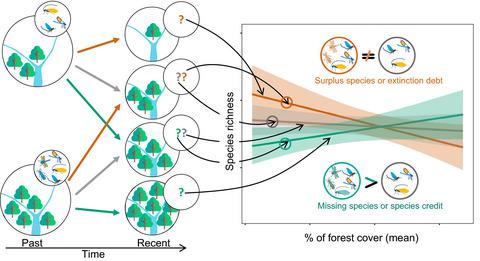当前位置:
X-MOL 学术
›
J. Appl. Ecol.
›
论文详情
Our official English website, www.x-mol.net, welcomes your
feedback! (Note: you will need to create a separate account there.)
Interactive persistent effects of past land‐cover and its trajectory on tropical freshwater biodiversity
Journal of Applied Ecology ( IF 5.0 ) Pub Date : 2020-07-25 , DOI: 10.1111/1365-2664.13717 Edineusa P. Santos 1 , Helene H. Wagner 2 , Sílvio F. B. Ferraz 3 , Tadeu Siqueira 1
中文翻译:

过去的土地覆盖及其轨迹对热带淡水生物多样性的互动持续影响
更新日期:2020-07-25
Journal of Applied Ecology ( IF 5.0 ) Pub Date : 2020-07-25 , DOI: 10.1111/1365-2664.13717 Edineusa P. Santos 1 , Helene H. Wagner 2 , Sílvio F. B. Ferraz 3 , Tadeu Siqueira 1
Affiliation

|
- Evidence indicating that ecological communities show delayed responses to environmental change has raised the need to better understand the effects of landscape history on biodiversity.
- We investigated how freshwater biodiversity is related to both recent and past land use change in tropical river catchments. More specifically, we analysed the relationship between biodiversity and change in forest cover that occurred across five decades, including landscape trajectories of forest gain and loss.
- The abundance of stream insects showed a more delayed response to landscape change than rarefied richness, whereas the Tsallis diversity index was not related to past forest cover. However, both alpha diversity and local abundance were related to mean forest cover across the five decades when conditioned by the trajectory of change. We found a negative relationship between the historical mean of forest cover and community descriptors in streams embedded in landscapes on a trajectory of forest loss, but a positive relationship in landscapes on a trajectory of forest gain.
- We provide the first evidence of delayed responses of tropical freshwater insect communities to landscape history and suggest that the magnitude of change in forest cover, mediated by its trajectory, is a major driver of delayed responses. We show that a trajectory of forest loss might result in both immediate loss of species and a set of species doomed for future extinction.
- Synthesis and applications. Delayed responses of multispecies communities to past landscape changes depend on their extent, frequency and intensity. Our findings indicate that, beyond the relative amount of forest cover within river catchments, the magnitude of change in forest cover mediated by its historical trajectory can be a major driver of delayed responses in stream communities. We suggest that, if biodiversity conservation is the main aim, stream restoration should be prioritized in catchments with higher forest cover, as even under a forest gain trajectory, stream communities continue responding to past landscape changes depending on how widespread and intensive changes were.
中文翻译:

过去的土地覆盖及其轨迹对热带淡水生物多样性的互动持续影响
- 有证据表明生态社区对环境变化反应迟缓,因此有必要更好地了解景观历史对生物多样性的影响。
- 我们调查了热带河流域的淡水生物多样性与最近和过去的土地利用变化之间的关系。更具体地说,我们分析了过去50年中生物多样性与森林覆盖率变化之间的关系,包括森林得失的景观轨迹。
- 溪流昆虫的数量比稀少的丰富度显示出对景观变化的更延迟的响应,而Tsallis多样性指数与过去的森林覆盖率无关。然而,当受到变化轨迹的影响时,阿尔法的多样性和当地的丰度都与整个五十年的平均森林覆盖率有关。我们发现森林覆盖的历史平均值与森林流失轨迹中的景观溪流中的群落特征之间存在负相关关系,而在森林获取轨迹中的景观中存在正相关关系。
- 我们提供了热带淡水昆虫群落对景观历史反应迟缓的第一个证据,并表明由其轨迹介导的森林覆盖变化幅度是反应迟缓的主要驱动力。我们表明,森林流失的轨迹可能会导致物种的立即丧失和注定将来灭绝的物种。
- 综合与应用。多物种社区对过去景观变化的延迟响应取决于其程度,频率和强度。我们的发现表明,除了河流流域内森林覆盖的相对数量之外,由其历史轨迹介导的森林覆盖变化幅度可能是溪流社区响应延迟的主要驱动力。我们建议,如果将生物多样性保护作为主要目标,则应优先在森林覆盖率较高的集水区恢复河流,因为即使在获得森林的轨迹下,河流群落也将继续根据过去的景观变化做出反应,具体取决于变化的广泛程度和强度。











































 京公网安备 11010802027423号
京公网安备 11010802027423号